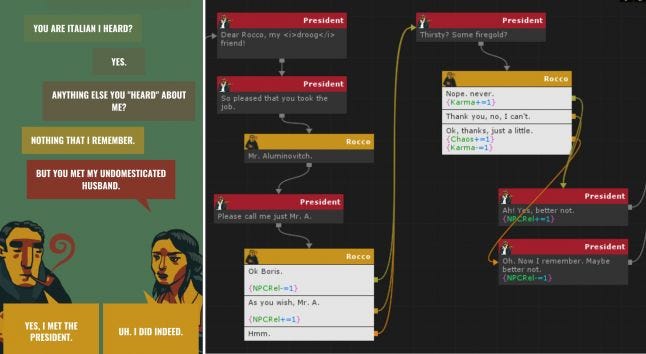This post is co-authored by Pietro Polsinelli and Daniele Giardini.

In this post we discuss two themes:
How to facilitate writing for games?
Given that writing say partially generative in-game dialogue is a specific process, how can one minimize the impact on writing of values from state and output variations technicalities?
and
How to design an in-game dialogue user interface?
Designing in-game dialogues doesn’t seem to generally get much attention with respect to other kinds of game assets. We look at existing usages and we point out features to be considered when designing dialogues’ user interface.
A note on the use of the author’s point-of-view. We sometime write as “we”, in the outlining sections, and sometime use “I” as a part may be one of the authors writing his direct experience, be it Daniele or Pietro. Bare with us - him - me :-)
How to facilitate writing for games?
Stories are remarkably useful tools for creating good games, Bogost aside. But writing for games is hard for several different reasons.
In The future of dialogue in games Adam Hines is quoted:
Writing for games and writing for anything else is a totally different job. It’s more like trying to solve a very complex mathematical problem than it is a pure writing exercise.
Most media have a predetermined, linear, progress. Even when the writer tries to hide this under a complex narrative, there's only one way to go from beginning to end. Under this aspect, games are a completely different medium: writing a game means dealing with mutations, branching narratives, and is a sort of chaos theory applied to storytelling.
Hence the writing style for games needs to be quite specific - this is from Writing for Animation, Comics, and Games:
Animation, comics, and games fall into the category I think of as “shorthand” writing. This is in contrast to prose writing, where a writer can write plot, description, and dialogue to any length, and can cover all of the senses—sight, sound, touch, taste, smell—using both external storytelling (description, dialogue) and internal storytelling (thought processes, emotional description).
This specialized form of “shorthand” writing requires the discipline to write within a structured format; to pare description down to an absolute minimum; to boil dialogue down to a pithy essence; and to tell concise, tightly plotted stories.
In the following we consider how shorthand writing merged with state and variations handling can be smoothened for writers using specific tools. Methodological advances in how writing can be prototyped and tested can make a crucial difference in the quality of results (see How We Design Games Now and Why for an historical perspective) and so adding practical writing applications to your toolset can be useful.
Another feature of writing for games is that it has specific properties in the testing process: when you write say a short novel, you can do testing by printing drafts on paper, or reading it out loud, but in all cases you are working on a unique draft. In the case of in game state you need a way to do quick testing and changes while testing multiple possible results.
For example this allows testing of the logic of what your characters end up saying in different situations.
Narrative in games can solve problems - but it must be capable to relate and change in connection with dynamic state.
Here is a problem described by Daniele that having a dynamic flow tool that supports interactive writing and testing can probably help to solve:
As a short out-of-theme anecdote, Pietro wanted me to write about one thing I mentioned in our talks, a thing that always kinda annoys me, and which represents a good example of bad flow. It's what I call the "wall of NPCs" effect, which is typical of RPGs but also of some adventure games.
It's when, for a few hours, you went around exploring and met no more than a couple people to talk to, then suddenly you reach a city. And kaboom, tons of people appear and, if you're a completionist / narrative - explorer like me, you HAVE to talk to each and every one of them. If the group of people was small, let's say four people, it would be a welcome change in pace. When the group is city-sized though, the flow completely breaks and you simply enter the "wall of NPCs" section of the game, which I find to be both interesting and stressful, mostly because all these people are not introduced gradually, but as a sudden presence, a feat, you have to overcome.
One solution to this problem is already used by less dialogue-centric games, where most NPCs are idiots with nothing to say. This removes depth from the characters, but keeps the flow, uh, flowing, since the player doesn't see them as a weight anymore. Still, I'm sure there's better solutions for more dialogue-centric games. Just something to ponder about.
So let’s have a look at the existing writing tools for games.
Inkle’s Ink
A remarkable tool that allows all above is Inkle’s Ink, presented generally by Jon Ingold here and in more technical detail in this GDC’s talk by Joseph Humfrey.




































